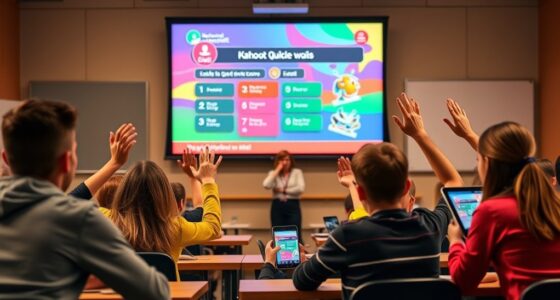A flipped classroom in stats shifts traditional lessons outside the classroom using videos and online resources, so you come prepared for active learning during class. Rather than passively listening, you’ll engage in problem-solving, discussions, and hands-on activities that deepen your understanding. This approach boosts your involvement, helps retain concepts, and develops critical thinking skills. As you explore more, you’ll discover how this method makes mastering stats more interactive and effective.
Key Takeaways
- Use online videos and tutorials to introduce statistical concepts before class, freeing up class time for active problem-solving.
- Incorporate interactive quizzes and simulations to reinforce understanding of statistical topics.
- Engage students in hands-on activities like data analysis projects during class to deepen statistical skills.
- Provide immediate feedback through digital tools to help students identify and address misconceptions in statistics.
- Foster collaborative discussions and experiments to make learning statistics more engaging and accessible.

Have you ever wondered how flipping your statistics class can transform your learning experience? The flipped classroom model turns traditional teaching on its head by shifting direct instruction outside of class time, allowing you to use class sessions for more interactive, hands-on activities. This approach boosts student engagement because you’re no longer just passively listening to lectures; instead, you’re actively applying concepts through problem-solving, discussions, and collaborative projects. The key to making this work seamlessly is leveraging technological tools that deliver content in flexible, accessible ways. Video lectures, online quizzes, and interactive modules are just a few examples that help you learn at your own pace and revisit material as needed. These tools allow you to absorb foundational concepts before class, freeing up time during in-person sessions for deeper understanding and practical application. Additionally, incorporating visual aids like charts and diagrams can enhance comprehension and retention of complex statistical ideas. With the flipped classroom, your engagement levels rise because you’re more involved in your own learning process. Instead of waiting for a teacher to explain everything during class, you come prepared, having already watched videos or gone through readings. This preparation enables class time to be used for discussions, group work, and real-world problem-solving, which makes the subject matter more meaningful. When you actively participate, you’re more likely to retain information and develop critical thinking skills. Additionally, technological tools facilitate this shift by providing instant feedback and personalized learning paths. For example, online quizzes can immediately show you where you might be struggling, so you can focus your efforts on those areas. This immediate feedback loop keeps you motivated and helps you monitor your progress in real time. Furthermore, the integration of digital tools creates an environment where learning becomes more dynamic and tailored to your needs. You can pause, rewind, or re-watch lectures, ensuring you understand each concept thoroughly before moving on. Many platforms also offer discussion forums and virtual office hours, giving you additional avenues to clarify doubts and deepen your understanding. This constant access to resources makes the learning process more flexible and less stressful, especially as you can choose when and how to engage with the material.
Frequently Asked Questions
How Can I Effectively Motivate Students in a Flipped Classroom?
To effectively motivate students, focus on boosting student engagement and fostering peer collaboration. You can do this by designing interactive activities that make learning fun and relevant. Encourage students to work together on problems, share ideas, and support each other. Recognize their efforts and progress regularly. When students feel involved and connected with peers, their motivation increases, making the learning experience more enjoyable and effective.
What Are Common Challenges Faced When Implementing Flipped Classrooms?
When implementing a flipped classroom, you often face challenges like maintaining student engagement and customizing content effectively. Students may struggle to stay motivated without traditional lectures, and you might find it difficult to tailor materials to diverse learning styles. Balancing engaging activities with personalized content can be tough, but addressing these issues head-on helps create a more effective learning environment. Focus on interactive tasks and adaptable resources to overcome these common hurdles.
How Do Assessments Differ in a Flipped Stats Course?
In a flipped stats course, assessments often differ by emphasizing application and understanding over rote memorization. You’ll encounter varied assessment formats like online quizzes, project-based tasks, and interactive problem sets, which encourage active learning. Grading criteria focus on critical thinking and participation, rewarding students for engagement and real-world problem-solving. This approach helps you demonstrate mastery in different ways, aligning with the flipped classroom’s goal of fostering deeper comprehension and active involvement.
What Technology Tools Best Support Flipped Learning in Statistics?
Did you know that 85% of students prefer online tools for learning? You should consider using interactive quizzes to engage students actively, helping them grasp concepts better. Collaborative platforms like Google Classroom or Padlet foster peer discussion and teamwork, essential for flipped learning. These tools make it easier to deliver content outside class, ensuring students come prepared and ready to participate actively during face-to-face sessions.
How Can I Ensure Student Accountability Outside Class?
To guarantee student accountability outside class, you should implement homework tracking by using online platforms that record submission times and completion rates. Additionally, participation monitoring tools can help you observe engagement with assigned tasks. Regularly review these data points, provide timely feedback, and set clear expectations. This way, you keep students responsible for their learning, encouraging consistent effort and active participation beyond classroom hours.
Conclusion
Don’t let the idea of extra prep hold you back. With a flipped classroom, you get to learn at your own pace and come prepared for engaging discussions. Sure, it might seem challenging at first, but the benefits—better understanding and more confidence—are worth it. Embrace this method, and you’ll find stats become less intimidating and more manageable. Give it a try, and you’ll see how effective and rewarding flipped classrooms can truly be.










